Verizon 4G LTE: Two Datacards and a WiFi Hotspot Massively Reviewed
by Brian Klug on April 27, 2011 12:11 AM EST- Posted in
- Smartphones
- Samsung
- Verizon
- LTE
- 4G
- Pantech UML290
- USB551L
- Mobile
- MDM9600
More SCH-LC11
So this brings me to my other chief complaint about the SCH-LC11. Even when connected to the beefiest of chargers, I found that the hotspot actually discharges faster than it can charge when it's connected to 4G LTE and actively serving clients with data. Remember that the USB charger that the hotspot ships with is 0.7A, 5V (3.5W). I tried the beefy 10W iPad charger, my similarly beefy 10W car charger, and a more generic 5W USB charger, and all failed to keep the SCH-LC11 from discharging while plugged in and transacting data. That’s positively mind-blowing to me.
For a while now, I’ve been secretly (well, not really secretly) running a fourth test on phones and wireless devices to measure WiFi hotspot battery life. Historically, WiFi tethering has been brutal on battery life, and I devised a test that I think is reasonably representative. For this test, I have two tabs of our standard page load test, and another two with flash, for a total of four tabs loading through a few dozen pages every 10 seconds. In addition, I have a 128kbps MP3 audio stream from smoothbeats.com playing in the background to keep data active constantly. There’s just one wireless client with a 802.11n WiFi card connected, though all this traffic reasonably approximates a few wireless clients all transacting data.
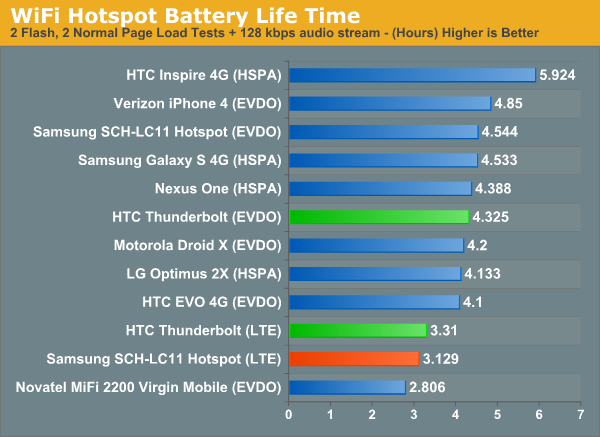
My initial battery life test results for the SCH-LC11 were actually thrown off because I expected it to have fully charged the device while I was using it and plugged in. About a half hour of use, and I was down to 82 percent in spite of being plugged in. I’ve seen the SCH-LC11 also discharge on EVDO, though it doesn’t happen nearly as rapidly as it does on LTE. I didn’t do enough testing to find out whether the device will eventually settle on some equilibrium, or discharge all the way to 0, which could make things frustrating if you intend on using the SCH-LC11 as your primary connection. Again I’m just confused as to why both the default charger is so small at 0.7A and why the device doesn’t fully follow the USB charging spec and draw more current from my other 10W USB chargers.
Under power is the ability to set different auto power off timeouts, and a much appreciated "never" setting. I’ve put together a full gallery of the configuration pages for the SCH-LC11.
SCH-LC11 Disassembled
I did decide to open up the SCH-LC11 as well, to see what WiFi chipset and device architecture is behind the web interface. Construction of the SCH-LC11 lends itself to easy disassembly, with no void stickers atop screws. Just four screws and some easy plastic tabs, and the thing comes open.
There’s a bottom plastic ring that has an antenna flex cable for WiFi and two gold pads. That antenna runs some length down the side of the device.
There’s one monolthic PCB that spans the entire device and immediately makes it pretty apparent why the Samsung hotspot is larger than the older MiFi which packed the PCB alongside the battery. There’s a modular antenna assembly that snaps onto the PCB and two gold contacts. Again two antennas are required for celluar right now thanks to the MIMO requirement in LTE. The EMI cans on the top and bottom of the board are super easy to remove and just snap on or off.
Inspecting the PCB we can see at the very center the Qualcomm MDM9600 which runs the show. Top left is a Qualcomm PM8028 PMIC which does power management and status LED control. Left of it is the hotspot’s internal configuration reset switch, and to the right is microUSB. To the right of the MDM9600 is a Qualcomm RTR8600 multi-band/mode RF transceiver for LTE bands, and down below it sits an Avago ACFM-7107 quadplexer.
Finally at the other side of the board is the SCH-LC11’s WiFi chipset, the Qualcomm WCN1312, which provides 802.11b/g/n support on the 2.4GHz band.
Finally on the reverse side of the board is a 1Gb (128MB) NAND for the MDM9600. There's more shots of everything in the gallery.
The Samsung SCH-LC11 is almost entirely Qualcomm design wins. I’m a bit surprised that the MDM9600 can drive the entire device management config and network routing without use of an external application processor, since I was under the impression that support for device manufacturers to use the onboard ARM core would only come in the next refresh of Qualcomm’s MDM lineup with MDM9615 and MDM8615. There is a marking difference however betwteen the markings on the MDM9600 inside the USB551L datacard and the SCH-LC11; the former is marked A2W126.0, the latter A2W206.0, which looks something like a hardware version system. Perhaps support for using the ARM processor came later and Samsung leverages that. Either way, to me it’s impressive that NAT routing and firewall rules are being handled at speeds sometimes over 20Mbps with no dedicated application processor.
Network performance on the SCH-LC11 is on par with other LTE gear overall, though a bit slower as I’ll show in the next section. Where the device really shines however is stability. I’ve found that both of the USB modems intermittently disconnect and sometimes require an unplug, replug, and search for device to regain connectivity. The SCH-LC11 consistently clung to 4G LTE everywhere I tested while in the 4G market, and clients were essentially always able to transact data. Samsung has done a nice job abstracting the sometimes erratic modem connectivity that happens during handover away in the device.









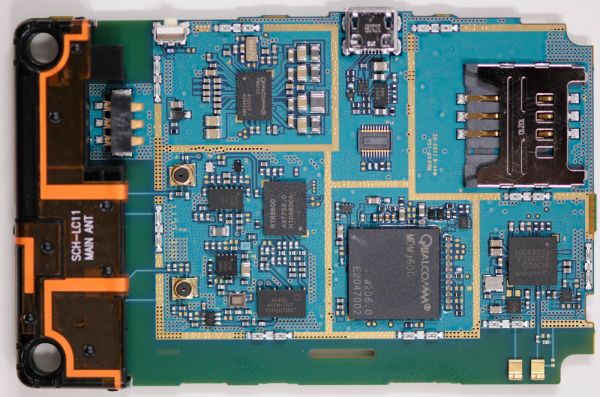
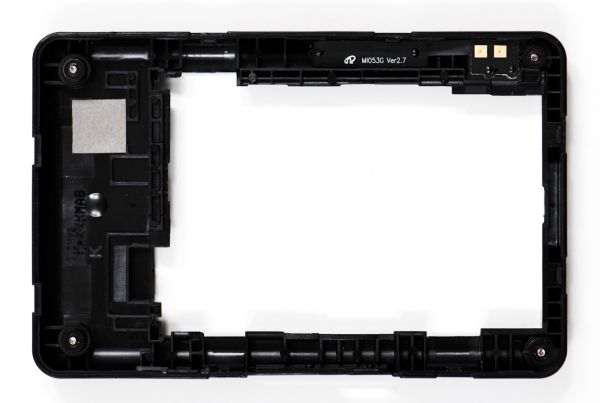
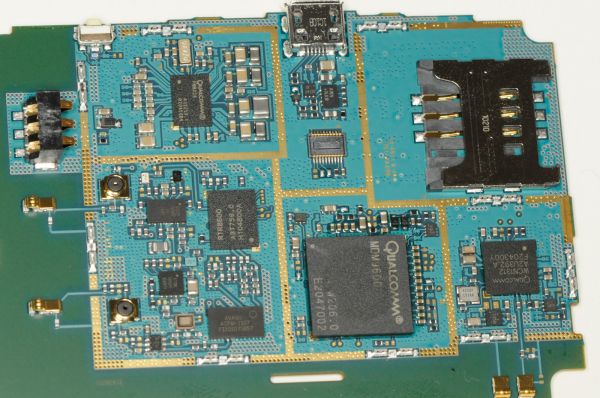
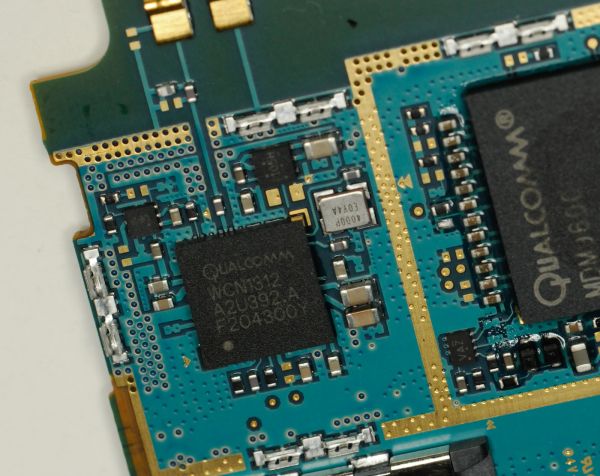
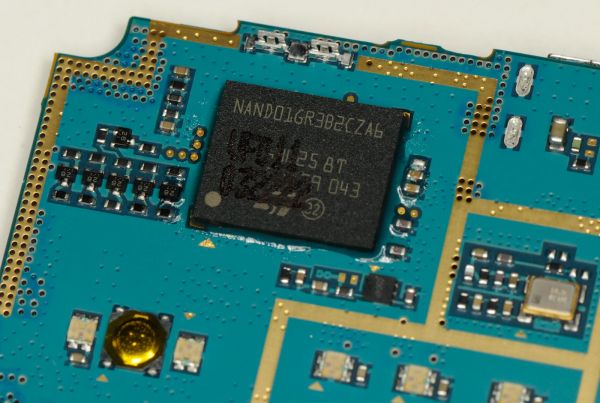














32 Comments
View All Comments
OctavioShaffer - Tuesday, November 13, 2018 - link
this very informative, i can now open my vpn server, through my Ip address 192.168.1.1. because recently i spend days just to search a to fix my problem. Thanks alot!strikeback03 - Wednesday, April 27, 2011 - link
I live in an LTE market and would be happy to accept some LTE devices if you don't want to be driving to Phoenix ;)For that matter I also have a Droid X with the stock 2.2 build.
Playing with a Thunderbolt at a Verizon store the data speeds are really quick. Will be interesting to see how much they drop off though with more users.
Penti - Wednesday, April 27, 2011 - link
They use 20MHz in 2.6GHz here in Sweden (few cities so far) so you can actually see speeds up to about 80 Mbits here, LTE-Adv on 800MHz is in the works of being deployed here now, but they will be using 10MHz spectrum. I'm guessing people in major cities will see 20-80Mbits and people in areas only covered by 800MHz will see 10-40Mbits. Latency is where it clearly matters though. Though 50 Mbits on 2x10MHz 700MHz is clearly at the top. It's not often you will see much of high speeds any way.To bad they pretty much price themselves out of the market though. A 16Mbit Turbo3G connection is less then half of what 4G costs here. For limitless traffic at least.
xp3nd4bl3 - Wednesday, April 27, 2011 - link
Love the graphing.mars2k - Wednesday, April 27, 2011 - link
Not good, I need USB tethering. This is a deal breaker for me. I need outside access in several places where wi fi is not allowed.Lord 666 - Wednesday, April 27, 2011 - link
Brian,Currently have an open ticket with VZW about the lack of public addresses. Have several LTE cards used with cradlepoints that are used for DMVPN backup connections and need public addresses. In testing, would randomly get nat'd address bring up a complete tunnel, but it was very rare. All of the IPs issued were 10.xxx in NYC.
Was told static public IPs will be available around May.
nerdydesi - Wednesday, April 27, 2011 - link
I'm curious on what you meant by this."Note that the Thunderbolt is a 2x1 device while the others are 2x2, which explains some of the upstream throughput distribution difference"
Do you mean that the other devices have more antennas than the Thunderbolt and thus why their speeds seemed to be faster than the Thunderbolt? Regarding the phone and its "unlimited data", I used 30gb in my last billing cycle and so far 70gb now with no peep from Verizon. It could also be that I'm currently a VZW employee. I hope that because I bought the phone, I can be grandfathered into the plan.
Also as a note, if you take the sim card from the Thunderbolt with its full voice and data plan and put that into a mifi or USB modem, you get the unlimited data as well. Just keep in mind you pay more per month due to having the voice along with it (which is useless on the modem devices), but still better than the current 5gb and 10gb caps. If you do vice versa, take the card from a modem to an LTE phone, you are charged for each minute of voice and each text unless you change your plan.
DanNeely - Wednesday, April 27, 2011 - link
" AT&T on the other hand has a sprinkling of lower block B and C licenses that are both 12MHz. AT&T also purchased Qualcomm's licenses to blocks D and E, which are both 6MHz unpaired, though it's not entirely clear how AT&T will integrate both blocks of unpaired spectrum. All total that gives AT&T between 24 and 36MHz of 700MHz spectrum, again depending on market."Since the only blocks that they own nationwide are the 6mhz D and E blocks shouldn't it be 12 to 36mhz of spectrum. Looking at auction maps it appears there're fairly large areas where ATT didn't win the A or the B blocks.
http://www.cellularmaps.com/700_auction.shtml
Brian Klug - Thursday, April 28, 2011 - link
That's a good point. If they can manage to either TDD or FDD both of those it should be 12 to 36. Just don't forget about the lower C block which was involved prior to this latest auction, that's the 24 that I'm thinking of.With 12 MHz of spectrum they can run 5 MHz FDD channels which really won't be much faster than current WCDMA systems. I guess that's why I mentally discounted it.
-Brian
Lothsahn - Wednesday, April 27, 2011 - link
I notice that with my Sprint aircard, I maintain the 3G connection even during extended trips across the nation. However, the 4G connection on the same aircard appears to be unable to handoff and loses its connection while traveling constantly. I find that my connection disconnects every 2-3 minutes when actually moving. However, if I'm stationary in a building, it'll maintain the connection for hours.What results did you have with LTE for these sorts of usage scenarios?